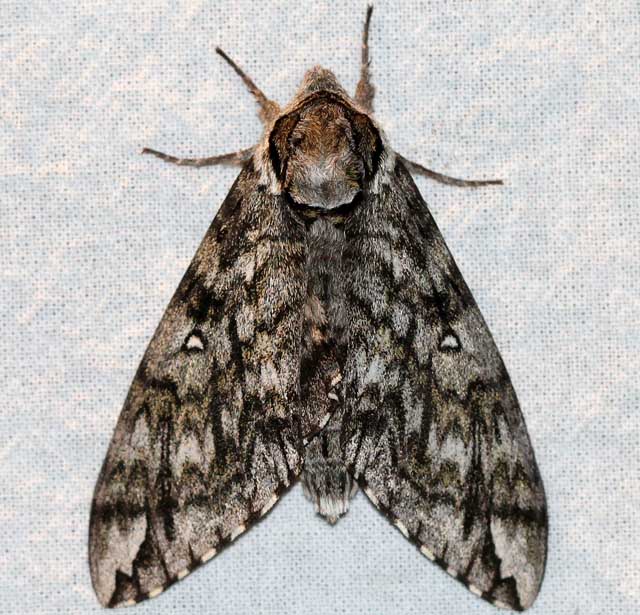Carlton County, Minnesota
Sphingidae

Sphinx canadensis, Carlton County, Minnesota,
July 14, 2019, courtesy of Gary Walton.
|
|
Updated as per James P. Tuttle's The Hawk Moths of North America; August 2, 2014 Updated as per BAMONA; August 2, 2014 Dedicated to Gary Walton, July 25, 2019; June 6, 8, July 9, 2021 |

I (William Oehlke) have included many species not on the BAMONA list for Minnesota; I believe they are or might be present.
This page is dedicated to Gary Walton who has photogrpahed a number of Saturniidae and Sphingidae, attracted to his incandescent porch light in Carlton County, Minnesota. Gary reports the following Sphingidae from Carlton County: Ceratomia undulosa, Dolba hyloeus, Lapara bombycoides, Sphinx canadensis, Sphinx kalmiae, Sphinx poecila, Amorpha juglandia, Pachysphinx modesta, Paonias myops, Smerinthus cerisy, Smerinthus jamaicensis, Darapsa choerilus, Hyles lineata.

Ceratomia undulosa, Barnum, Carlton County, Minnesota,
June 7, 2021, courtesy of Gary Walton.

Please also send your sightings to BAMONA, an excellent on-line resource.
Visit Carlton County Sphingidae Larvae: Caterpillars; Hornworms
Visit Minnesota Catocala: Underwing Moths
If you are travelling, you can find active Sphingidae checklists for all countries in North, Central, and South America and the Caribbbean via the links at
North, Central, South American Sphingidae checklists



Dolba hyloeus, Barnum, Carlton County, Minnesota,
July 9, 2021, courtesy of Gary Walton
Sphinginae subfamily
Macroglossinae subfamilyDilophonotini tribe:
Hemaris thysbe nectaring at milkweed flowers, Barnum, Carlton County, Minnesota, |
 | Hemaris diffinis, the Snowberry Clearwing or Bumblebee Moth. This moth is widely distributed and is found in Cook County. Note black legs and black on abdomen. |
 | Hemaris gracilis, The Slender Clearwing or Graceful Clearwing: This day flier is not commonly reported. Note red and red on dorsal surface of abdomen. |
 | Hemaris thysbe, the Hummingbird Clearwing. It is not difficult to see why many gardeners would mistake an Hemaris thysbe moth for a small hummingbird as it hovers, sipping nectar from flowers through a long feeding tube. Note off-white legs. |


 | Amphion floridensis, the Nessus Sphinix: This day flier is widely distributed. If you have Virginia Creeper, you probably have the Nessus Sphinx. Two bright, distinct, narrow yellow bands are often visible on the abdomen. |
 | Darapsa choerilus, Azalea Sphinx (GW). Orangey brown forewings. The lower wings of this hawkmoth are a solid brownish-orange, matching the body colour. You will often see this species listed as Darapsa pholus, especially in older literature. |
 | Darapsa myron, Virginia Creeper Sphinx; Grapevine Sphinx: If you have foodplants indicated in common names, you might have this species nearby. Lower wings orange. The inner edge of dark postmedian band is outwardly quite convex. Some individuals are orangey-brown. |
 | Hyles euphorbiae, Spurge Hawk Moth. The body is light brown with various white and dark brown markings, while the wings have a conspicuous tan, brown, and pink or red color pattern. |
 | Hyles gallii, Bedstraw Hawk Moth or Gallium Sphinx.Relatively thick, very irregular, transverse, tan bar on dark brown forewing. |
 | Hyles lineata, the White-lined Sphinx (GW). This species is not officially recorded in Cook County. It is a strong migrator from the south, and probably appears late summer or early fall. |
Use your browser "Back" button to return to the previous page.
This page is brought to you by Bill Oehlke and the WLSS. Pages are on space rented from Bizland. If you would like to become a "Patron of the Sphingidae Site", contact Bill.
Please send sightings/images to Bill. I will do my best to respond to requests for identification help.
 Show appreciation for this site by clicking on flashing butterfly to the left. The link will take you to a page with links to many insect sites. |
I very much appreciate all the many images that have been sent to me, or of which I have been granted permission to copy and post from other websites. All images on this site remain the property of respective photographers.
If you would like to contribute to the maintenance of this website by sending a contribution to
Bill Oehlke
Box 476
155 Peardon Road
Montague, Prince Edward Island, C0A1R0
Canada
your donation would be much appreciated and would be used for
1) paying for webspace rental;
2) paying for computer maintenance and software upgrades;
3) purchases of additional text reference material (journals and books) in anticipation of expanding the site to a worldwide Sphingidae site;
4) helping to pay my daughter's tuition (completed spring 2013); with anything left over going to humanitarian aid.
If you are mailing a check from USA, please use $1.10 postage ($1.25 is 2019 rate so check with post office as rates seem to be rising annually). Donations can also be made through Paypal via the button below.